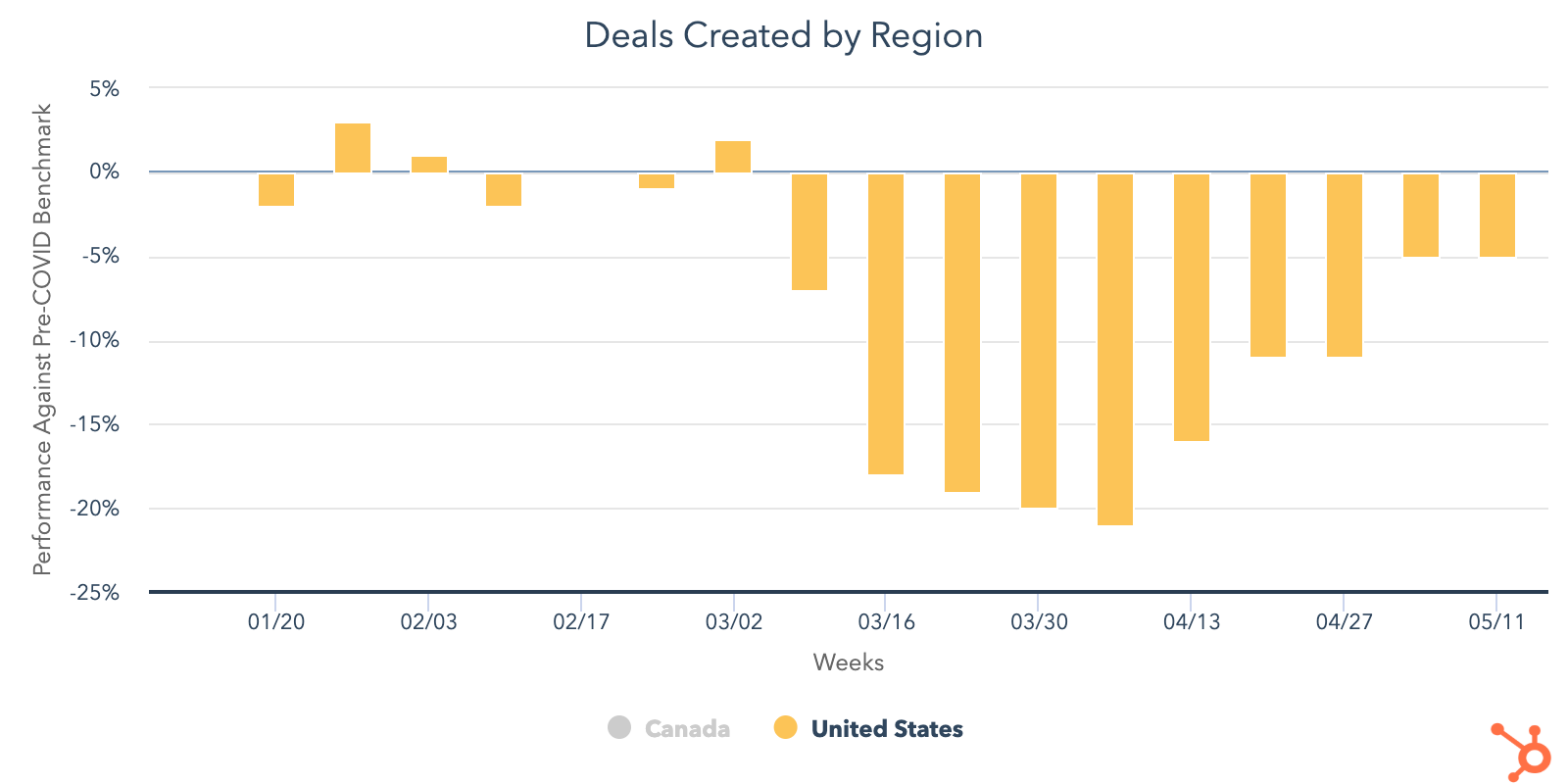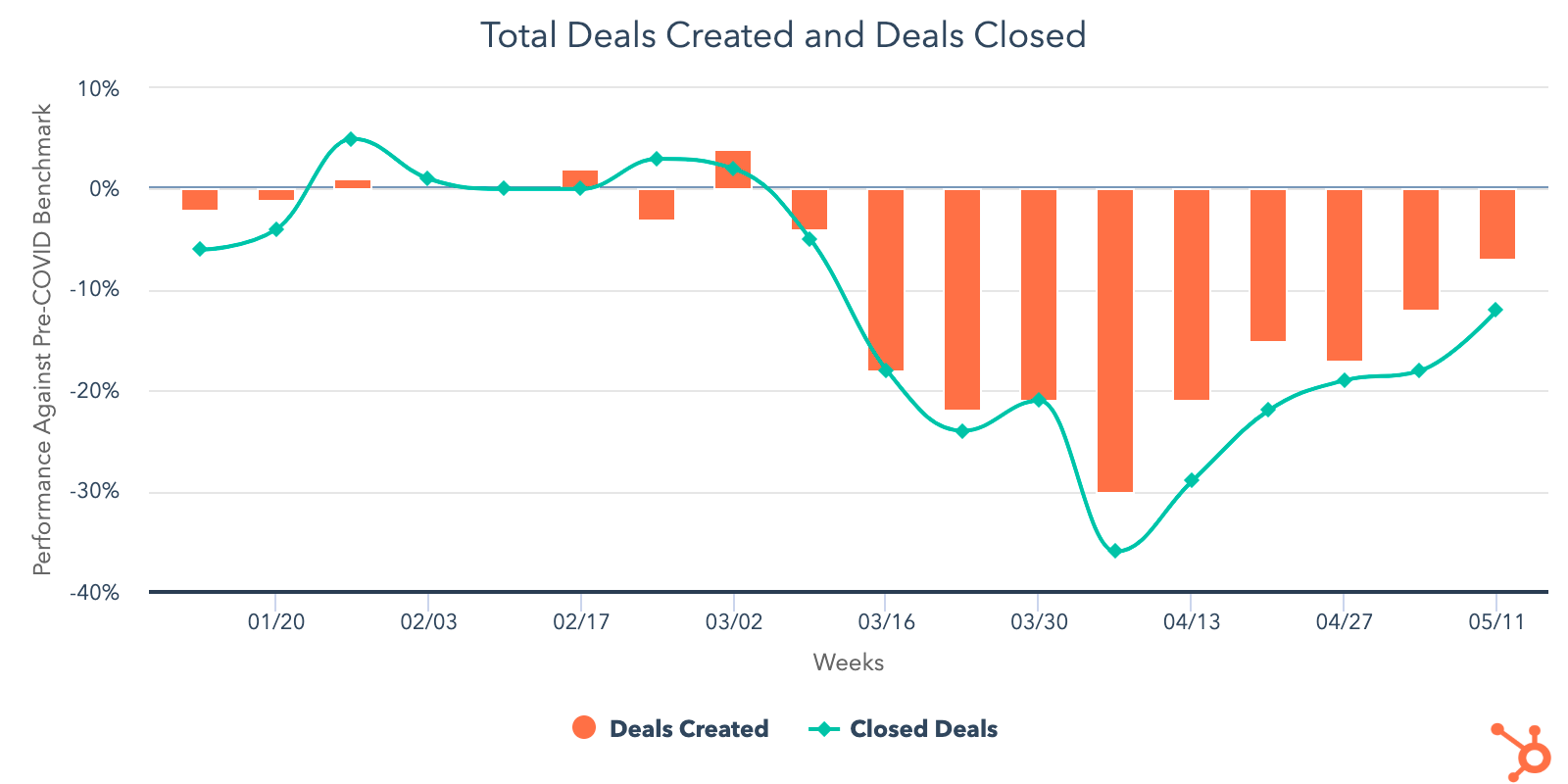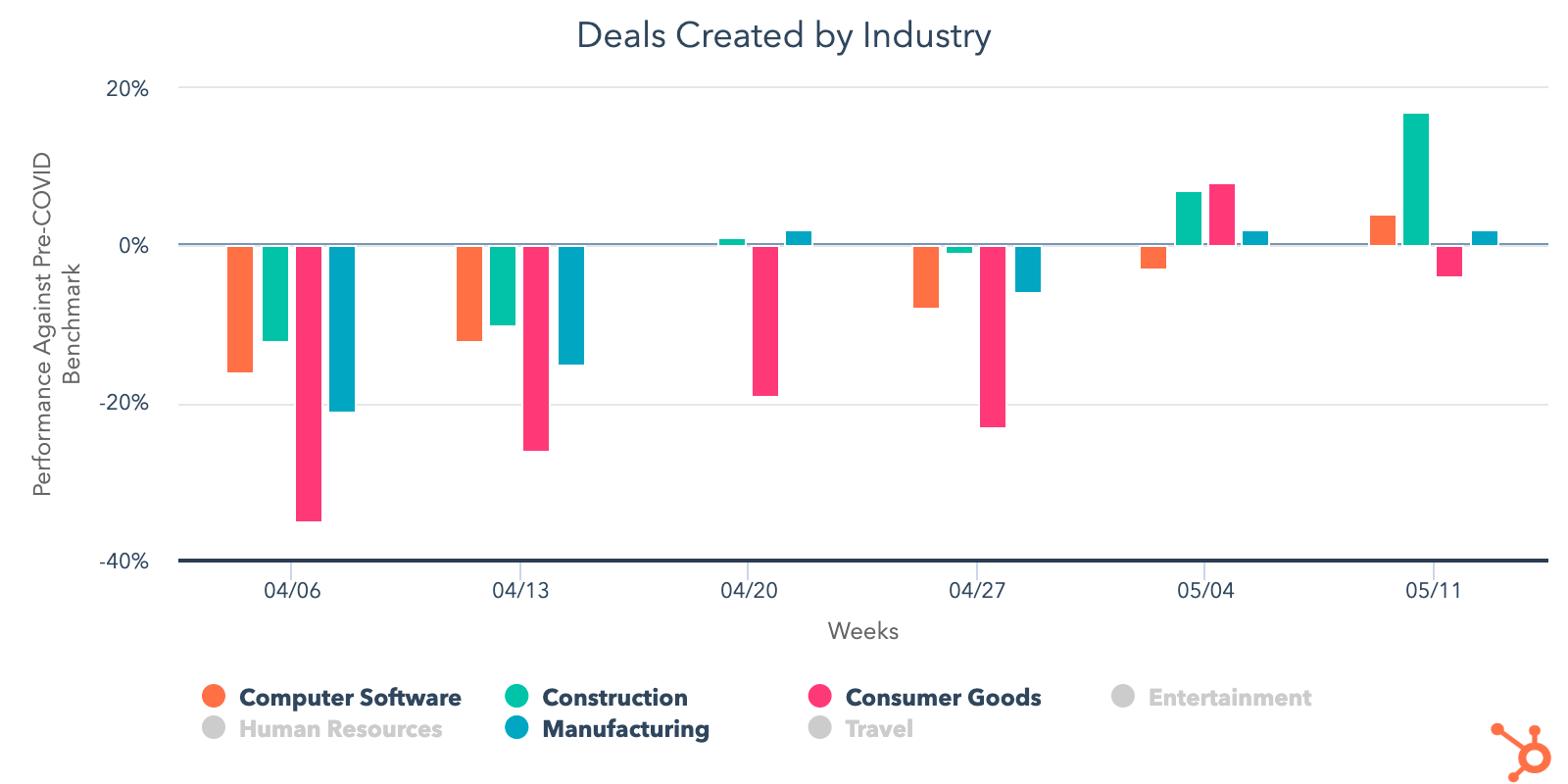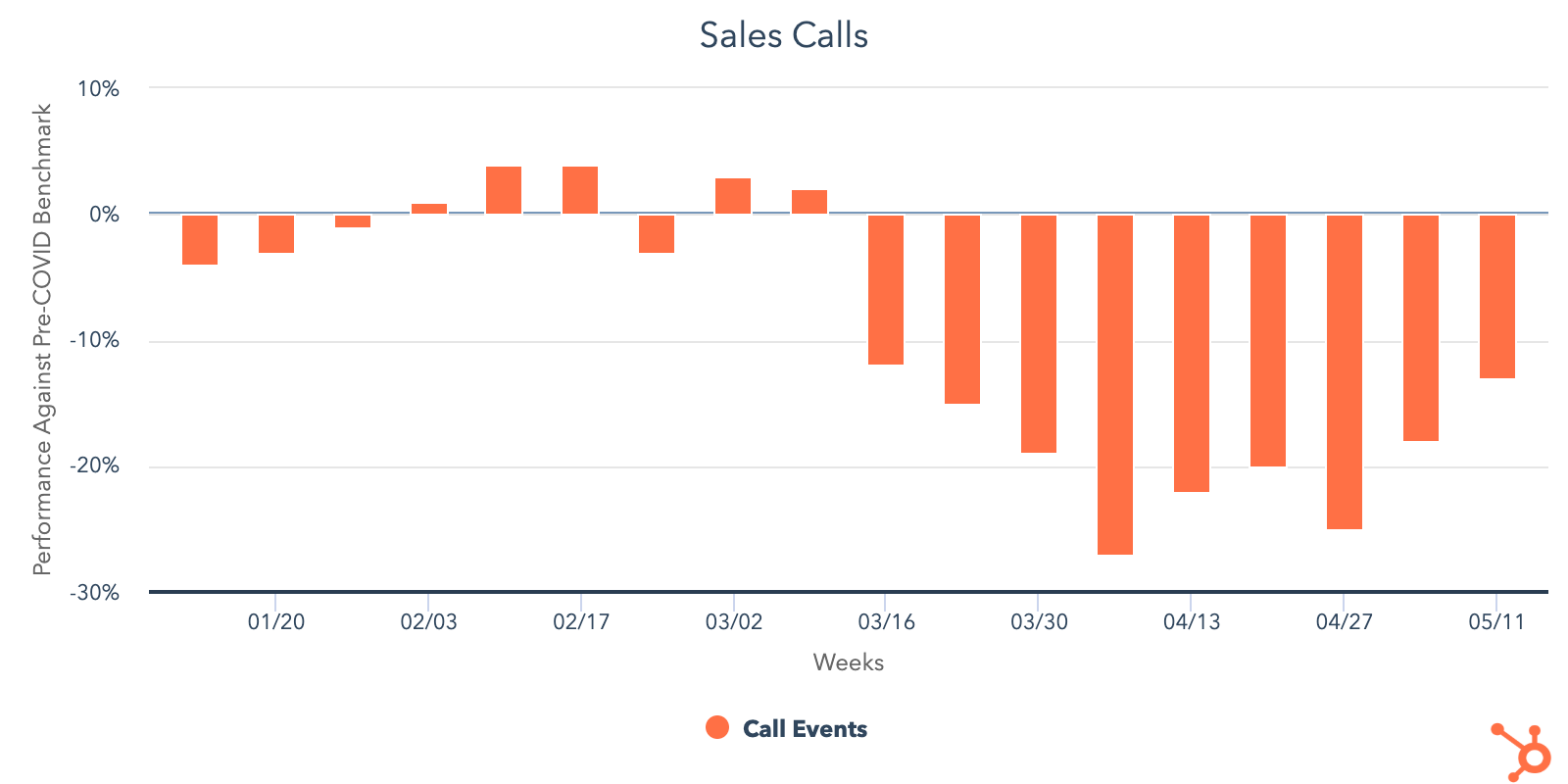For the last few months, businesses around the world have had to rapidly adapt to the impact of COVID-19.
In a time where it seems like things change every day, it can be difficult to gauge whether the challenges your business is facing are widespread.
That's why we're publishing week-over-week benchmark data for core business metrics like website traffic, email send and open rates, sales engagements, close rates, and more. These core metrics are split by region, company size, and industry cuts, so you can explore data for companies most similar to yours. You can find the data, and more context on the dataset and sources, here.
Because the data is aggregated from our customer base, please keep in mind that individual businesses, including HubSpot's, may differ based on their own markets, customer base, industry, geography, stage, and/or other factors.
These insights are refreshed every Thursday morning ET, and will be accompanied by this short writeup. You can find past writeups using this timeline.
We hope to establish useful benchmarks to measure your business against, and serve as an early indicator of when short- or long-term adjustments may be needed in your strategy.
What We're Seeing
Here are the three key takeaways from the most recent week's data:
1. Deals created and closed gain positive momentum as some industries and countries show encouraging performance towards mid-May.
After a 6% increase during the week of May 4, global deals created rose another 6% last week. Deal creation is still 7% below pre-COVID levels, but this metric has been trending in a positive direction over the past few weeks. The number of deals closed also increased by 8%, which is a promising sign after seeing the recent rise in deals created earlier this month. The combined growth of deals created and deals closed should provide optimism for sales teams, especially those working in industries that haven't been as structurally impacted by COVID-19.
Almost all industries experienced an increase in deal creation during the week of May 11, except for consumer goods which dropped 11% from the previous week. There are now four industries that are trending close to or above pre-COVID levels as construction is 17% above, computer software is 4% above, and manufacturing is 2% above the benchmark. Consumer goods is trending 4% below pre-COVID levels, and although it experienced a drop in deals created last week, that dip was accompanied by a 17% increase in deals closed-won, which is a hopeful sign for sales teams as we move towards the end of May.
For the last several weeks, we've been paying attention to countries that have been in the news for reopening their economies. Italy, Spain, and Germany, all saw increases in deals created during the week of May 11. Italy experienced the largest bump with a 12% increase in deal creation and a 14% increase in deals closed. Germany had a 5% increase in deals created and stayed on par with global averages for deals closed. Germany's performance is similar to Australia's as deals created there were 6% higher during the week of May 11 and are now trending just above pre-COVID levels.
The United States is another country that's near the top of our watchlist. You can explore its macro-regional data here, but we'll provide a more detailed breakdown later in this post.
2. Sales teams return to calling, marketing metrics show strong engagement, and the demand on inbound channels remains high.
After weeks of remaining flat, sales email response rates saw a slight increase during the week of May 11. While response rates are still below pre-COVID levels, this recent rise in engagement has given way for more sales activity.
Previously, email response rates reached their lowest average this year, but as they show signs of recovery in May, sales teams are able to resume higher levels of other, more direct prospecting activities, like phone calls. Call volume has increased 16% since the week of April 27 and contact growth has remained consistent with pre-COVID averages during the week of May 11. Now that more countries and states are starting to open back up, we're seeing businesses returning to traditional outreach channels like calling clients and booking meetings.
Marketing metrics, on the hand, remain strong. Marketers sent fewer emails this week, but send and open rates continue to trend well above pre-COVID levels. Email engagement was particularly high during the week of May 11 as open rates are currently trending 29% above the benchmark. That's roughly a 10% boost from the previous week.
Engagement for other marketing channels remains strong as well. Customer-initiated conversations increased 4% during the week of May 11 and are 33% above pre-COVID levels. Web traffic was up last week, too, sitting at 23% above the benchmark. This indicates that there's still a great demand for inbound strategies as people start to gravitate towards different marketing channels.
3. The United States remains on par with global sales activity as the country begins to reopen its economy.
As states across the U.S. continue to reopen businesses and lighten COVID-19 restrictions, sales activity has begun to rebound. Deal creation has remained steadily improved over the past five weeks and currently the U.S. is only trending 5% below pre-COVID levels. Deals closed-won increased by 2% as well, resulting in the most closed-won deals for the country since the week of April 6, when nearly all of the countries we're tracking experienced a significant dip. Although the U.S. is still 10% below the pre-COVID benchmark for deals closed, we hope this will improve as we near toward the end of May.

The volume of sales emails for the U.S. continues to trend above pre-COVID levels landing at 70% for the week of May 11. Response rates remain below pre-COVID averages and, like sales volume, remained flat compared to the previous week. Additionally, after trending downward in mid-March, call volume in the U.S. is now up 4%, but still sits 10% below pre-COVID levels. As more states start to relax their COVID-19 legislation, we expect sales activity to yield a positive trend over the next few weeks.
Marketing metrics for the U.S. have remained on par with global averages. Email send and open rates have been trending well-above the benchmark since mid-March and last week open rates hit a year-best, reaching 31% above pre-COVID levels. Web traffic has been really strong in the U.S., too, as last week marked the 15th week in a row where web traffic has been recorded above the benchmark. It's now sitting at 28% above pre-COVID levels.
What This Means for Businesses
Sales teams need to reinvent how they prospect.
While sales results are incrementally improving week-over-week, salespeople are still spending a great deal of time reaching out to poor-fit prospects. The deal pipeline metrics are an encouraging sign that more businesses are reentering buying processes, but it's still too early to tell how much of this growth will be sustained. For now, it's a safe bet that your sales team should continue prioritizing high-interest, good-fit buyers rather than indiscriminately prospecting.
Resources to Help
- Watch the replay of our Adapt 2020 webinar on selling through uncertainty
- Refresh your email outreach with these sales templates.
- Start using video in your sales outreach to engage more prospects.
- Use this guide to increase your sales close rates.
- Lead with empathy in sales emails to build rapport and increase response rates.
Consider whether online advertising is a fit for your business.
The significant dip in advertising spend tells us that many businesses have paused their ad campaigns either temporarily or indefinitely. There's an opportunity for companies to enter a more affordable market. Whether or not this approach is right for your company entirely depends on your audience and offering, but if online ads work for your business, now may be a good time to un-pause campaigns.
Resources to Help
- Attend next week's Adapt 2020 webinar on retaining customers during difficult times like these
- Get up to speed on using Facebook Lead Ads with this beginner's guide to building audiences and ads
- Read our ultimate guide to online advertising
- Plan your investment with this guide to budgeting for advertising
- Set up and run campaigns using HubSpot Ads, Facebook Lead Ads, or Google Ads
Free Software to Get Started
- HubSpot CRM is free and comes with included advertising and sales acceleration tools, including free 1:1 video, meetings, and chatbot tools
- Gmail and Google Calendar integrations with HubSpot
- Zoom integration with HubSpot
- LinkedIn Sales Navigator integration with HubSpot
- Check out what HubSpot's app partners are offering at this time with this list of relief initiatives

from Marketing https://ift.tt/2LNMI8k




No comments:
Post a Comment